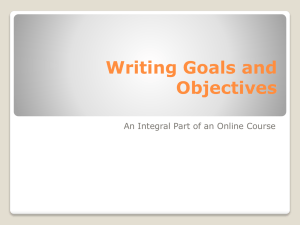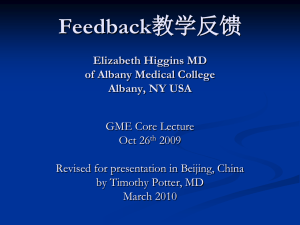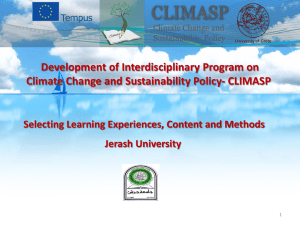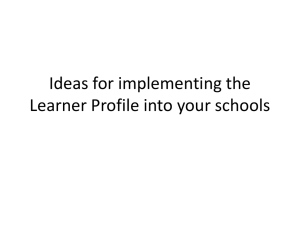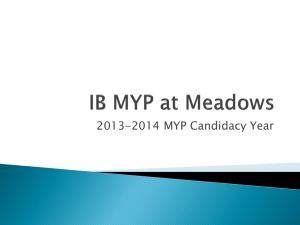Objectives Formative and Summative Assessment
advertisement
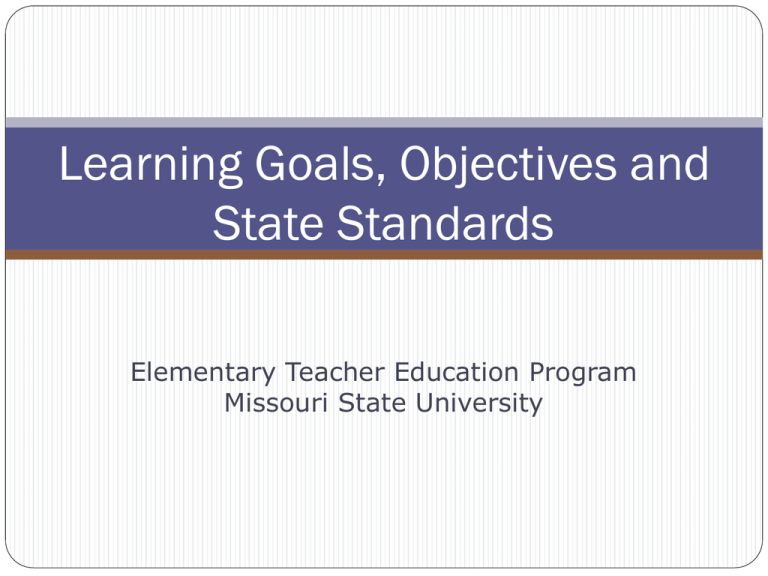
Learning Goals, Objectives and State Standards Elementary Teacher Education Program Missouri State University Guiding Question: What is a standards-based learning goal and objective? Learning Goal 1: The TC will know that a learning goal states the standards-based information students will know when the lesson is complete; learning goals are stated in the “The student will know that…….” format. Learning Goal 2: The TC will know that an objective is a standards-based statement of what the students will do to demonstrate how well they have learned the content/or skill, under what conditions and to what degree; objectives are stated in the “The student will ……………..” format. Learning Goal 1----Objectives: Obj. 1. The TC will identify (select) all well-written standards-based learning goals when reviewing his/her own TWS. Obj. 2 The TC will identify (select) all learning goals that do not conform to the guidelines for formulating effective learning goals when reviewing his/her own TWS. Obj. 3 When developing his/her TWS, the TC will write learning goals to conform to 5 of the 6 guidelines for formulating effective learning goals. Learning Goal 2----Objectives: Obj. 1. The TC will identify (choose) all well-written standards-based objectives when reviewing his/her own TWS. Obj. 2 The TC will identify (choose) all objectives that do not conform to the guidelines for formulating effective objectives when reviewing his/her own TWS. Obj. 3 When developing his/her TWS, the TC will write objectives to conform to 6 of the 7 guidelines for formulating effective objectives. A well written learning goal…… Focuses on the standards-based concepts and information the student will learn… …not on learning activities he or she will do. Focus on CONCEPTS, rather than on activities. Learning Goals are… . . . specific Learning goals are very specific. This means that they should describe precisely the standards-based information, concepts or ideas the learner is expected to know at the end of the lesson. Learning Goals… . . .describe the knowledge students will acquire through lesson activities. Learning goals describe the knowledge the student will construct in his/her brain. This means that learning goals should relate what the student should know after the instruction. Achievement of learning goals is measured by assessment of related objectives. Learning Goal SS 1.1.A.K -----Identify why laws and rules are made. LG-----The student will know that laws ands rules are made to keep us safe. Parents, teachers and police officers help us understand and obey rules and laws. Learning Goal SC 3.1.A. 3rd a.---- Describe the basic needs of most plants. Learning Goal: The student will know that plants need air, water, light, nutrients and the right temperature to live and survive. Different plants need different amounts of water, light, nutrients and warmth to be healthy. Learning Goal: SC 3.1.B. 3rd a.---- GLE: Describe and sequence the stages in the life cycle (for a plant) of seed germination, growth and development, reproduction, and death. Learning Goal: The student will know that a plant begins as a seed with an embryo inside; it grows into a seedling with roots, stems and leaves; flowers grow on the plant and produce seeds. A plant grows and develops, creates new plants and then dies. This is called the life cycle of a plant. Learning Goal: SS 4.1.B.3rd--- Conduct a cost-benefit analysis. Learning Goal: The student will know that a costbenefit analysis is an evaluation of whether the benefits of carrying out a project or decision outweigh the costs of carrying out that project or decision; opportunity cost is the most important alternative that is given up as a result of a specific economic decision. Learning Goal CA W.2.A.3rd --- Compose text in a format appropriate to audience and purpose. Learning Goal: The student will know that when he/she writes, he/she is communicating to a specific audience and for a specific purpose. Learning Goal: CA L&S.1.B.3rd: Demonstrate listening behaviors. Learning Goal: The student will know that when he/she is listening to others, he/she should demonstrate appropriate listening behaviors such as preparing to listen, listening without interruptions, and maintaining eye contact. Learning Goal: MA.3.C.3rd----apply and describe the strategies used to compute up to 3-digit addition or subtraction problems. LG: The student will know that there is more than one strategy for solving addition and subtraction problems up to 3 digits. Repeated subtraction, subtracting as adding up, and counting by 2s, 5,s or 10s can be used to compute 3-digit numbers. Learning Goal: MA 2.C.3rd--- Represent and interpret one-tomany correspondence data using pictures and bar graphs. LG: The student will know that he/she can make bar graphs to represent the correspondence between supply and demand. Guidelines for Learning Goals Concise: one or two sentences in length Focused: on the standards-based concepts and information the student will learn Specific: describes precisely what the learner is expected to know Outcome-Based: describes what the learner will know after instruction, not on learning activities Describes expected knowledge: describes the desired information, concepts or ideas students are expected to learn, not merely a direction of change or a teacher activity Format: written as a “The student will know that……. statement A well written objective…… Focuses on what the student will do to demonstrate what they have learned with regard to the learning goal… …not on learning activities they will do. Focus on DEMONSTRATING learning goal CONCEPTS and SKILLS, rather than on activities. Objectives are… . . . specific Objectives are very specific. This means that they should describe precisely what the learner is expected to do to demonstrate knowledge of concepts or skills. Objectives are… . . .measurable Objectives are measurable. This means that objectives should describe learning goal outcomes that can be measured; objectives should be seen or heard. Observable, Measurable Action Verbs Remember---define, describe, find, identify, list, name, etc. Understand---arrange, interpret, clarify, paraphrase, translate, etc. Apply---demonstrate, execute, carry out, illustrate, implement, etc. Analyze---differentiate, select, organize, integrate, outline Evaluate---assess, defend, evaluate, predict, support, justify, etc. Create---compose, generate, formulate, plan, design, produce, construct, etc. Depth of Knowledge (DOK Levels) 1) Recall---list, identify, quote, recite, state, define, calculate, name 2) Skill/Concept---categorize, classify, estimate, predict, construct, identify patterns, compare, make observations 3) Strategic Thinking---formulate, hypothesize, cite evidence, compare, investigate, develop a logical argument 4) Extended Thinking---connect, synthesize, critique, analyze, create, prove Objectives are… . . .outcome based Objectives are outcome based. This means that the objective is going to state what the learner should be able to do after the instruction is complete. The process of how the instruction happens is not considered in an objective. Of note… • Avoid words like understand, learn, and know. They are not measurable because there is no product involved. Sometimes the degree of accuracy is implied by words such as correctly, accurately and successfully. Not all lessons result in a tangible product. Therefore, when students verbally demonstrate their learning, the measurable action involves telling, explaining, or discussing. Objectives… . . .describe student behavior Objectives describe student behaviors. This means that objectives should relate what the student should be able to do after the instruction. Writing Objectives ABCD Method (Heinich, et al., 1996) Four parts Audience Behavior Condition Degree Audience The audience is learner(s) that the objective is written for. This is usually written "the learner" or "the student" however it could be written as specific as "The 2nd grade student". Less is more. Make it simple so that the objective does not get too wordy. Behavior The behavior is the verb that describes what the learner (audience) will be able to do after the instruction. This is the heart of the objective and MUST be measurable AND observable. In addition, these verbs MUST be specific. Verbs such as know, understand, comprehend, and appreciate are difficult to measure and are therefore not good choices for objectives. Condition Conditions are the circumstances under which the objectives must be completed. What will the instructor allow the student to use in order to complete the instruction? What equipment or tools can the student have access to such as a calculator, map, the book, class notes, etc? Obviously it would be much more difficult to make calculations without a calculator than with one. Degree The degree identifies the standard that the learner must meet to reach acceptable performance. In other words, what degree of accuracy does the learner have to achieve in order that his/her performance be judged proficient? The degree of accuracy should be related to real-world expectations. Degree of accuracy can be related as a time limit (in 20 minutes), or a number of correct answers (7 out of 10), or a range of accuracy (90%) or combined quantitative and qualitative standard, (a paragraph with an effective main idea and at least 3 related supporting details). Include a degree that is actually measurable/ compatible with the behavior and condition. A common error is something like write a paragraph with 90% accuracy. A better way would be write a paragraph with an effective main idea and at least 3 related supporting details. Degree Avoid stating a percentage accompanied with the word "completion" or "participation" (i.e. with 100% completion). In the majority of cases, this is not appropriate. Ask yourself “Do I want students to merely complete or participate in the assignment or do you want them to do it with some level of accuracy. For example: After reading the book John, Paul, George, & Ben , the students will complete the coatof-arms activity with 100% participation. Students could master the objective by putting anything down on the template (even if off of topic). Contain four parts A = Audience The person(s) the objective is written for. B = Behavior The kind of learning outcome expected. C = Condition The circumstances in which the learner is to exhibit the learned knowledge. D = Degree The standard that the learner must meet to reach acceptable performance. Guidelines for Writing Objectives Concise: one or two sentences in length Focused: one and only one aspect of behavior Specific: describes precisely what the learner is expected to do Outcome-Based: describes what the learner should be able to do after instruction, not learning activities Describes expected behavior: describe the desired end product, not merely a direction of change or a teacher activity Describes observable behavior: focus on observable behavior, not on teacher illusions or indefinable traits Measurable: use action verbs that describe an observable behavior that is measurable Given a world map or globe, the student will identify (circle, color, point to) Mexico on the first attempt Given a world map or globe of the world----C the student---A will identify (circle, color, point to) Mexico---B on the first attempt--D 1.K.A -----Identify why laws and rules are made. LG-----The student will know that laws and rules are made to keep us safe. Parents, teachers and police officers help us understand and obey rules and laws. Obj. 1---Given a set of pictures, the student will identify (circle, color, point to) the 3 pictures of children following rules at school and in the community. the student---A will identify (circle, color, point to) children following rules at school and in the community---B set of pictures---C the 3 pictures---D 1.K.A -----Identify why laws and rules are made. LG-----The student will know that laws and rules are made to keep us safe. Parents, teachers and police officers help us understand and obey rules and laws. Obj. 2---After identifying pictures of children following rules at school and in the community, the student will explain a rule from each picture and why it is important. After identifying pictures of children following rules at school and in the community---C the student---A will explain a rule and why it is important---B from each picture---D SC 3.1.A. 3rd a.---- Describe the basic needs of most plants. LG---The student will know that plants need air, water, light, nutrients and the right temperature to live and survive. Different plants need different amounts of water, light, nutrients and warmth to be healthy. Obj. 1---When creating a poster showing a specific plant, the student will include a representation of 4 of the 5 survival needs of plants. When creating a poster showing a specific plant---C the student---A will include a representation of survival needs of plants---B 4 of the 5 survival needs of plants---D CA L&S.1.B.3rd: Demonstrate listening behaviors. LG---The student will know that when he/she is listening to others he/she should demonstrate appropriate listening behaviors such as preparing to listen, listening without interruptions, and maintaining eye contact. Obj. 1---The student will do 4 things to prepare to listen (clear their desk, face the speaker, look at the speaker, stop talking) before each classmate gives his/her presentation. The student---A will prepare to listen (clear their desk, face the speaker, look at the speaker, stop talking)---B before each classmate gives his/her presentation---C do 4 things; each---D CA L&S.1.B.3rd: Demonstrate listening behaviors. LG---The student will know that when he/she is listening to others he/she should demonstrate appropriate listening behaviors such as preparing to listen, listening without interruptions, and maintaining eye contact. Obj. 2---The student will listen without interruption to a 3 minute presentation given by each of his/her classmates. The student---A will listen without interruption---B by each classmate for 3 minutes--D presentations given by classmates---C MA.3.C.3rd----apply and describe the strategies used to compute up to 3-digit addition or subtraction problems LG---The student will know that there is more than one strategy for solving addition and subtraction problems up to 3 digits. Repeated subtraction, subtracting as adding up, and counting by 2s, 5,s or 10s can be used to compute 3-digit numbers. Obj. 1--- Given base 10 blocks and a place value mat, the student will show how he/she uses at least 2 different addition and subtraction strategies to calculate money earned, saved, spent, and donated in an income/expense ledger. the student---A will show how he/she uses at least 2 different addition and subtraction strategies to calculate money earned, saved, spent, and donated in an income/expense ledger.---B Given base 10 blocks and a place value mat---C at least 2 different---D For more information and practice go to: http://edtech.tennessee.edu/~bobannon/writing_objectives.html

